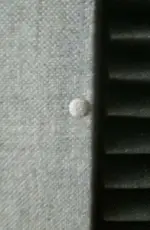I've built a ton of these- some just this week actually, so here's some info while still fresh in my mind.
Pine does work just fine. I also like melamine style particle board which cuts well. With fiberboard you have to cut cut the frames just under 2" to get a tight fit when you wrap it.Measure the actuall thickness of the rockwool to see if it's actually 2' or under. Also if space allows, make the frames 2'x 4' inside diameter to keep from from having to cut the rockwool. If the panels are bigger than 2'x4' use a brace in the middle to keep the frame from collapsing when you stretch the fabric around them. IMHO, forget using L brackets and glue just use 1 +5/8' coarse thread drywall screws two for each corner. predrill all holes- make a template to drill with and it goes quickly. You don't really need fabric on the backs if they are against the wall- (saves a few more $$)
Hanging is always a challenge and my hanging method, assuming they are going to stay in place awhile, is to simply predrill holes around the frame ( before wrapping with fabric) and screw them to the wall or ceiling right through the fabric using longer drywall screws. If going into drywall I use plastic drywall inserts in the wall. I find the older plaster and lath give enough grab to hold it without them. Also, you'll want to countersink these frame holes- which hides the mounting screws and also makes the holes easier to find once wrapped in fabric. Be careful when hanging them this way that you don't pull the fabric with the screws. The finishing touch is to put plastic push in caps ( Home depot) on the the heads of the drywall screws. they may need a dab of glue to hold. Prepaint the caps to match the material color you've chosen. I found a new textured paint at HD which really blends well with guilford material and is pretty slick. will try to post photos of these later.



